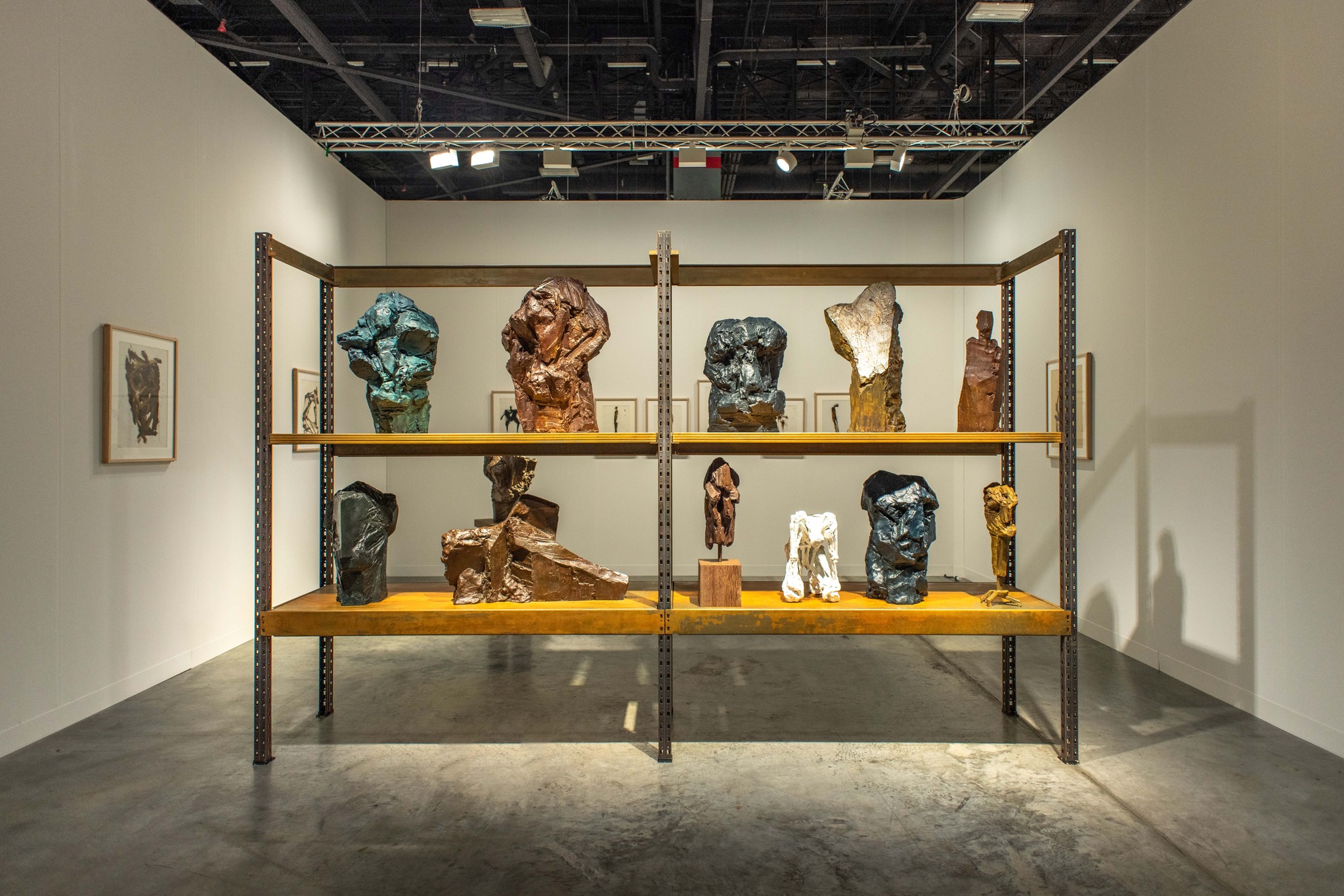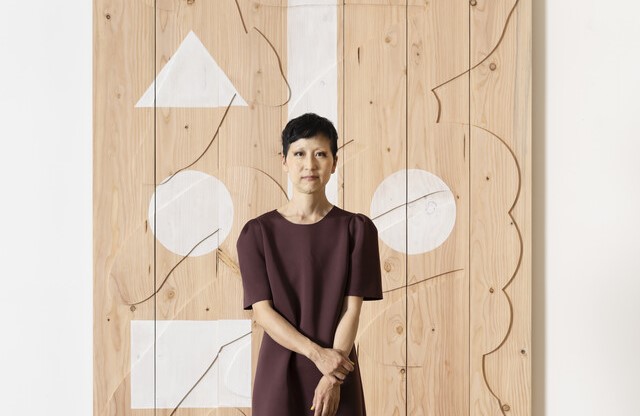Kim Beom (b. 1963) humorously transforms the artist’s imagination from small everyday events into real objects. His work ranges from object works that transform everyday objects into new objects, to drawings and video works that realize the artist’s imagination, to publications in the form of monographs.
While his work is lighthearted and playful on the surface in its depiction of various everyday situations, it is deeply concerned with the existence and meaning of people and things, and is also sharp and sober, shaking up stereotypes and exposing the absurdities of society. The artist’s work, which creates cracks in socially learned perceptions, leads the viewer to self-reflection that “what you see is not all of what you see.”
 Kim Beom, Untitled, 1994. Courtesy of Leeum Museum of Art ©Kim Beom
Kim Beom, Untitled, 1994. Courtesy of Leeum Museum of Art ©Kim BeomAround the ’90s, Kim was interested in the material aspects of the canvas and the meanings of the materials used to create its images, exploring possibilities beyond the painting plane. For example, his 1994 work Untitled, in which he marks the canvas with a directive, transforms the work from a visual object to an object of perception that must be read and thought through. The textual device continues to appear in Kim’s work, transforming from a simple device to a script or poetic narrative.
 Kim Beom, Untitled (News), 2002 ©MMCA
Kim Beom, Untitled (News), 2002 ©MMCAThe single-channel video work of 1 minute and 42 seconds, Untitled (News), was edited by recording television news at the same time every day, cutting out the anchor’s words and pasting them back together into a script written by the artist. The contents of the script include the dull and trivial daily life of modern people and the artist’s wishes, which are conveyed through the appearance and voice of an authoritative news anchor. This work reflects the artist’s critical perspective on how mass media influences the public unilaterally and deconstructs the symbolic authority of the media through editing.
Untitled (News) has been exhibited in many major exhibitions in Korea and abroad, including the 51st Venice Biennale, Korea Pavilion, and the 8th Istanbul Biennale.
 (From left) Kim Beom, A Draft of a School of Inversion, 2009. Maeil Holdings Co., Ltd. collection. ©Leeum Museum of Art / Kim Beom, A Draft of a School of Inversion (Perspective), 2009. Maeil Holdings Co., Ltd. collection. ©Leeum Museum of Art / Kim Beom, A Draft of a Safe House for a Tyrant (Perspective), 2009. Maeil Holdings Co., Ltd. collection. ©Leeum Museum of Art / Kim Beom, A Draft of a Safe House for a Tyrant, 2009. Maeil Holdings Co., Ltd. collection. ©Leeum Museum of Art
(From left) Kim Beom, A Draft of a School of Inversion, 2009. Maeil Holdings Co., Ltd. collection. ©Leeum Museum of Art / Kim Beom, A Draft of a School of Inversion (Perspective), 2009. Maeil Holdings Co., Ltd. collection. ©Leeum Museum of Art / Kim Beom, A Draft of a Safe House for a Tyrant (Perspective), 2009. Maeil Holdings Co., Ltd. collection. ©Leeum Museum of Art / Kim Beom, A Draft of a Safe House for a Tyrant, 2009. Maeil Holdings Co., Ltd. collection. ©Leeum Museum of ArtProduced since 2002, Kim’s “Blueprints and Perspectives” series are imaginative works that involve “seeing and reading” images, symbols, and texts. The works present imaginary architectural or mechanical structures with functionality, such as an up-side-down school building or a safe house for a tyrant.
These imaginary structures represent aspects of the human world toward which the artist has long entertained questions; the worldview they depict is a pessimistic one governed by oppression and violence, injustice and deception. Humans in the works are eventually reduced to simple symbols, becoming nothing more than secondary components of a vast structure. Depicted serenely and realistically, the “Blueprints and Perspectives” allude to how such contradictory structures are not too far removed from the social base that sustains our reality.
In 2016, Kim developed his critique of these social structures into a more practical form with the project “Interior Items for Tyrants,” in which he created a practical cycle of creating, selling, and donating. The project does not remain confined to the exhibition: it expands into the realm of design and crafts with the sale of products that might appeal to tyrants and donation of the proceeds to serve the public good.
 Kim Beom, A Ship That Was Taught There is No Sea, 2010. Maeil Holdings Co., Ltd. collection. Courtesy of Leeum Museum of Art. ©Kim Beom
Kim Beom, A Ship That Was Taught There is No Sea, 2010. Maeil Holdings Co., Ltd. collection. Courtesy of Leeum Museum of Art. ©Kim BeomIn 2010, Kim released his series of “Educated Objects,” in which he shows the blind spots of the curriculum and the absurdity of our educated reality in his own unique way, and invites us to reflect on how we are being educated and what we look like as educated people. One of the works, A Ship That Was Taught There Is No Sea, a model ship sealed in a box and a video of a lecture in which the ship is taught about the different aspects of the world.
The video covers the geological, meteorological, and astronomical information about the Earth, but it also contains the false information that the Earth is only land. The image of a ship assembled in a world where its essence can never be realized represents the individual whose wishes are frustrated by systemically controlled education, or who lives in a world that is contrary to the truth, having acquired knowledge that is riddled with errors.

Kim Beom, Painting “Yellow Scream,” 2012 ©Kim Beom
Painting “Yellow Scream” is a work that adopts the format of a tutorial video. The teacher demonstrates step-by-step how to create an abstract painting with yellow lines, and his method involves capturing different “screams” in the choice of colors and the movements used to draw the lines. The video capturing the process of screaming out loud while creating an abstract painting line by line humorously represents the artist’s painstaking efforts and struggles to reach uncertain ideas and meanings.
Kim’s work, which appears to be a throwaway joke but is deeply meaningful, invites the audience to see the world differently, to think differently, to create cracks in what we know, what we’ve been taught, and what we consider common sense.
“The most fascinating element of art is the truth and misunderstanding of an image.”

Artist Kim Beom ©STPI
Based in Seoul, Kim Beom held his solo exhibition at various international institutions including Leeum Museum of Art (Seoul, 2023), Kunsthal Aarhus (Aarhus, Denmark, 2019), STPI (Singapore, 2017), Hayward Gallery (London, 2012), REDCAT (Los Angeles, U.S., 2011), and Art Sonje Center (Seoul, 2010).
The artist’s international biennale participations include 12th Sharjah Biennial, 9th Gwangju Biennale, 6th Media City Seoul, Korean Pavilion at 51st Venice Biennale, 8th Istanbul Biennale, and 1st Taipei Biennale. Kim’s works are in the prestigious collections of the Museum of Modern Art (MoMA), New York; M+, Hong Kong; Cleveland Museum of Art; Museum of Fine Arts, Houston; and the National Museum of Modern and Contemporary Art, Gwacheon, Korea.















